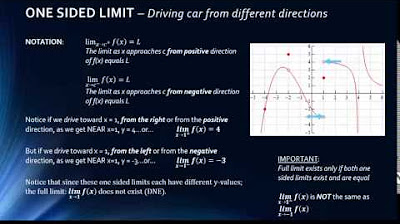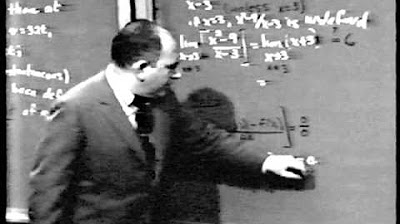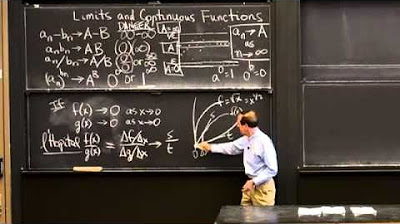Lecture 13: Achilles, Tortoises, Limits and Continuity
TLDRThis lecture delves into the fundamental concept of limits in calculus, which underpins both derivatives and integrals. The instructor clarifies the historical vagueness of limits and presents the rigorous 19th-century definition, using epsilon-delta notation. The talk also explores the related concepts of continuity and differentiability, illustrating how these mathematical ideas apply to real-world phenomena and functions. The lecturer uses examples and Zeno's paradoxes to explain these concepts, emphasizing the importance of limits in calculus and their formalization in mathematical discourse.
Takeaways
- 📚 The lecture focuses on the fundamental concept of limits in calculus, which is essential for defining derivatives and integrals.
- 🔍 The definition of limits was historically vague and took nearly 200 years after the introduction of calculus by Newton and Leibniz to become mathematically rigorous.
- 🤔 The intuitive idea of limits has been present since ancient times, but a formal definition was only established in the 19th century.
- 👨🏫 Newton's view of limits was described as vague, using phrases like 'ultimate ratio of evanescent quantities', indicating the challenge in formalizing the concept.
- 🏁 The script introduces Zeno's Paradox of Achilles and the Tortoise to illustrate the concept of limits and how they can be used to resolve seemingly paradoxical situations.
- 🔢 The idea that real numbers, such as 0.999... (repeating), are equal to 1 is presented as an example of a limiting process.
- 📉 The process of finding a derivative is demonstrated through the function f(x) = x^2, showing how the limit is used to find the slope of the tangent line at a point.
- 📈 The formal definition of a limit is presented using the ε-δ (epsilon-delta) approach, which is a precise mathematical way to describe how values approach a certain limit.
- 🔄 The concept of continuity is introduced as a property where the value of a function at a point is predictable from its neighboring values.
- 📐 Differentiability is explained as a stronger condition than continuity, where a function has a derivative at a point if it can be magnified to look like a straight line.
- 🛠️ Practical applications of calculus are hinted at, suggesting that the next lecture will explore how calculators and computers utilize calculus for complex tasks.
Q & A
What is the fundamental concept of calculus discussed in the lecture?
-The fundamental concept of calculus discussed in the lecture is the limit, which is essential for defining both the derivative and the integral.
Why were the definitions of derivative and integral considered vague historically?
-The definitions of derivative and integral were considered vague historically because the concept of limits, which underpins these definitions, was difficult to formalize mathematically until the 19th century.
What is the significance of the limit concept in the development of calculus?
-The limit concept is significant in the development of calculus because it provides the technical foundation that makes the derivative and integral possible. However, the rigorous mathematical definition of limits was not established until nearly 200 years after the introduction of calculus.
How did Newton describe the concept of limits in his Principia?
-Newton described the concept of limits as the 'ultimate ratio of evanescent quantities,' which refers to the ratio of quantities not before they vanish nor afterwards, but with which they vanish. He also mentioned that these ultimate ratios are not truly the ratios of ultimate quantities but are limits toward which the ratios of quantities decreasing without limit always converge.
What is Zeno's Paradox of Achilles and the Tortoise, and how does it relate to the concept of limits?
-Zeno's Paradox of Achilles and the Tortoise is a thought experiment where Achilles, a fast runner, gives a tortoise a head start in a race. Zeno argued that Achilles could never pass the tortoise because for every point Achilles reaches, the tortoise moves a little further ahead, creating an infinite sequence of points. This paradox relates to the concept of limits by illustrating the idea that despite the infinite sequence, Achilles will eventually reach the same point as the tortoise in a finite amount of time.
What is the mathematical notation used to represent the limit of a function as x approaches a certain value?
-The mathematical notation used to represent the limit of a function as x approaches a certain value is 'lim (x → c) f(x) = l', where 'lim' stands for limit, 'x → c' indicates x is approaching the value c, and 'f(x) = l' means the function f of x approaches the limit l.
How does the concept of real numbers relate to the concept of limits?
-The concept of real numbers relates to the concept of limits in that real numbers can be represented as infinite decimal expansions, such as 0.999... (which is equal to 1). This concept allows for the precise definition of limits, as it provides a way to describe quantities that approach certain values infinitely.
What is the formal definition of a limit in the context of a function?
-The formal definition of a limit states that the limit of a function f(x) as x approaches c equals l if for every ε (epsilon, a small positive number), there exists a δ (delta) such that if the distance between x and c is less than δ, then the absolute value of the difference between f(x) and l is less than ε.
What is the relationship between continuity and differentiability in functions?
-Differentiability implies continuity, meaning that if a function is differentiable at a point, it is also continuous at that point. However, continuity does not necessarily imply differentiability. A function can be continuous at a point but not differentiable there, such as at a point of discontinuity or a sharp corner.
Why are polynomial, trigonometric, exponential, and logarithmic functions important in calculus?
-Polynomial, trigonometric, exponential, and logarithmic functions are important in calculus because they are all differentiable. This means they have derivatives, which can be used to analyze changes and rates of change in various mathematical and real-world problems.
Can a function be continuous but not differentiable?
-Yes, a function can be continuous but not differentiable. An example of such a function would be one with a sharp corner or a vertical tangent at a point, which prevents it from having a derivative at that point, even though it is continuous.
Outlines
📚 Introduction to Calculus and the Concept of Limits
The lecture begins with an introduction to the fundamental concept of calculus, the limit, which is essential for defining both the derivative and the integral. The instructor acknowledges the vagueness in the historical definition of limits and the challenge it posed to formalize mathematically. The goal of the lecture is to define the limit rigorously and discuss foundational ideas of calculus, including continuity and differentiability. The historical context is provided by referencing Newton's and Leibniz's understanding of limits, which was intuitive but not mathematically rigorous until the 19th century.
🏃♂️ Zeno's Paradox of Achilles and the Tortoise
The second paragraph delves into Zeno's Paradox of Achilles and the Tortoise to illustrate the concept of limits. It describes a race where Achilles, being faster, gives the tortoise a head start. The paradox suggests that Achilles can never overtake the tortoise because for every point Achilles reaches, the tortoise moves slightly ahead. The lecture uses this paradox to introduce the idea of real numbers and the limit, explaining that Achilles and the tortoise will eventually meet at a specific point, represented by the repeating decimal 1.1111..., which is equal to 1.
🔢 Real Numbers and Limiting Processes
This paragraph explores the concept of real numbers and their relation to limiting processes. It presents the idea that a decimal point followed by an infinite string of digits defines a real number. The example of 0.999999... is used to demonstrate that this repeating decimal is equal to 1, not just almost 1. The paragraph also discusses the application of limits to derivatives, showing how the limit process is used to define the derivative of a function, such as f(x) = x^2 at the point x = 1.
📉 Formal Definition of a Limit
The fourth paragraph provides a formal definition of a limit in the context of a function. It explains that a limit of a function f(x) as x approaches a value C is a number L, which is approached by the function's values as x gets arbitrarily close to C. The formal definition is presented using the Greek letters epsilon (ε) and delta (δ) to describe the relationship between the challenge distance around the limit and the interval around C. The paragraph also includes a graphical explanation and a historical note on when this definition was established.
📝 Formal Proof of a Limit and Continuity
The lecture continues with a formal proof of a limit, using the example of the function f(x) = 2(x^2 - 4)/(x - 2) and demonstrating that the limit as x approaches 2 is 8. The proof involves choosing a delta value in response to a given epsilon challenge, showing that the function values are within the epsilon neighborhood of the limit. The concept of continuity is introduced as a function whose value at a point is predictable from its neighboring values, and it is formalized as the limit of the function values as x approaches a point being equal to the function's value at that point.
🛤️ Continuity and Differentiability
The sixth paragraph discusses the concept of continuity, using the analogy of a car driving on a road to explain that a continuous function's value at any point can be predicted by its neighboring values. It contrasts continuous functions with those that have jumps or kinks, which are not continuous. The paragraph then introduces differentiability, explaining that a function has a derivative at a point if it can be magnified to look like a straight line. Functions with kinks or sharp points are not differentiable, whereas differentiable functions must also be continuous.
📊 Differentiability in Real-World Functions
The final paragraph explores differentiability in the context of real-world functions. It notes that while some functions, like those with kinks, are not differentiable, many functions used to describe the physical world are differentiable. Examples include polynomials, trigonometric, exponential, and logarithmic functions, all of which can be combined in various ways to form new differentiable functions. The paragraph also mentions that while functions with a kink at a single point are differentiable everywhere else, it is possible to construct a function that is continuous but nowhere differentiable, characterized by an extremely jagged graph.
Mindmap
Keywords
💡Limit
💡Derivative
💡Integral
💡Continuity
💡Differentiability
💡Epsilon-Delta Definition
💡Real Numbers
💡Zeno's Paradoxes
💡Characteristic Difference Quotient
💡Newton and Leibniz
Highlights
Introduction to the fundamental concept of limits in calculus, which is crucial for defining derivatives and integrals.
Historical difficulty in formalizing the concept of limits, with a delay of nearly 200 years from calculus' introduction for a rigorous definition.
Newton's and Leibniz's intuitive understanding of limits without a mathematically rigorous definition.
Zeno's Paradox of Achilles and the Tortoise to illustrate the concept of limits and real numbers.
Real numbers and the concept that 0.999... is equal to 1, demonstrating the nature of limits.
Application of limits to derivatives, using the example of the function f(x) = x^2 to show the limiting process.
Intuitive understanding of limits through the behavior of a fraction as x approaches a certain value.
Formal definition of a limit in the context of a function, using epsilon-delta notation.
Historical development of the epsilon-delta definition of limits in the 1850s.
A formal proof using the epsilon-delta definition to establish a limit in a function.
The concept of continuity in functions, relating to the predictability of function values by neighboring values.
Differentiability as a stronger condition than continuity, with examples of functions that are not differentiable.
Examples of real-life phenomena that are conceptually non-differentiable, such as light reflection.
Differentiability of common functions used in physics and mathematics, such as polynomials, trigonometric, exponential, and logarithmic functions.
Existence of functions that are continuous but nowhere differentiable, with infinitely jagged graphs.
Overview of the foundational mathematical ideas of calculus discussed in the lecture.
Transcripts
Browse More Related Video

Limits, L'Hôpital's rule, and epsilon delta definitions | Chapter 7, Essence of calculus

Math 1325 - Lecture 9.1 - Intro to Calculus & Limits

Unit I: Lec 4 | MIT Calculus Revisited: Single Variable Calculus

AP Calculus AB and BC Unit 2 Review [Differentiation: Definition and Basic Derivative Rules]

Limits and Continuous Functions

Calculus Chapter 1 Lecture 7 Limits
5.0 / 5 (0 votes)
Thanks for rating: